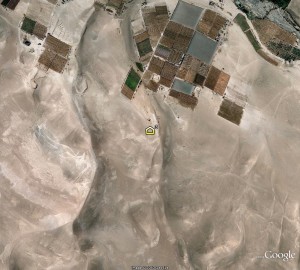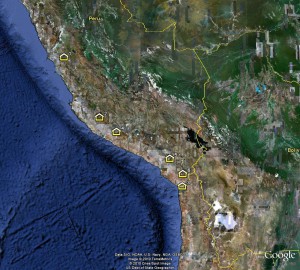- The value of Pavlovsk. Jeremy delivers a slap.
- CIRAD on kinky sex among the baobabs.
- “I had never heard that there were distinct varieties of the jackfruit, although of course such a thing was reasonable, so I naturally wanted very much to taste one.” Naturally.
- Wild relative of pea gets a weird hybrid in-ex situ conservation treatment.
- A Cowpea Story, an illustrative children’s book by Vicky Inniss-Palmer, tells the hopeful story of a cowpea named Catalina and her struggle to overcome illness and disease with the help of scientists. Meanwhile, scientists meet.
- Urban gardeners, beware lead. And nurture your pollinators.
- Reading this, anyone would think nobody had ever researched banana Xanthomonas wilt.
- Improved dairying in Kenya.
- Vavilov Institute’s comprehensive update on Pavlovsk.
- ICRISAT to put in place new market-oriented strategy which will use a “systems perspective in setting our priorities to ensure that all important issues along the dryland agriculture value chain are addressed.”
- Meanwhile, ASARECA asks for ideas on how to intensify one of those dryland systems in the face of climate change.
- ICIMOD promotes herbal gardens in schools.
- Botanic gardens get wrists slapped over their inattention to genetics.
Brassica bounty
Couldn’t resist today’s trifecta of Brassica papers. At the meta level, there’s “Origin and Domestication of Cole Crops (Brassica oleracea L.): Linguistic and Literary Considerations” in Economic Botany. Then some of the same authors follow up in GRACE with “AFLP analysis of genetic diversity in leafy kale (Brassica oleracea L. convar. acephala (DC.) Alef.) landraces, cultivars and wild populations in Europe.” And finally, in Plant Breeding, enjoy “The cytoplasm effect comparison between Brassica napus and Brassica carinata on floral characteristics of Brassica oleracea.” Enough to keep brassica boffins busy for weeks.
Nibbles: Heat, Pastoralism, Yams, Caimito, Pavlovsk, Beans, Tomatoes, Trees, Grasslands, Rice in LAC, Fossil sunflower, Apples, Fish in Africa
- Unpacking the heat of chillies.
- Debating pastoralism, a new journal.
- Celebrating (instead of growing?) yams.
- Economic Botany releases free download of paper on caimito domestication.
- More than 50,000 people care about Pavlovsk Experiment Station. Unstoppable?
- A bean diversity fair was held in Uganda on the 21st of June 2010. Did we miss it then?
- Searching for the Blue Zebra … tomato. Wonder if AVRDC know about it.
- Those blogging diplomats — How to make a scarf from a tree.
- Tibet’s disappearing grasslands. Pastoralists see item 2 above.
- IRRI DG says, in Latin America, that Latin America could be next global rice bowl. Well, he would, wouldn’t he. Very data-heavy presentation.
- One VERY remote sunflower wild relative. Very cool.
- Chaffey’s regular words of wisdom on anything botanical. Well, mostly wise. But more on that later…
- The history of the apple in the early US.
- IUCN does for African freshwater fish what it does best. Ring the alarm bell.
The Importance of Scientific Collections
The American Institute of Biological Sciences and the Ecological Society of America are among the scientific organizations around the world that have urged the Russian Federation to reconsider the decision to destroy the collections at the Pavlovsk Experiment Station. And they remind us that we do occasionally need to relate our concerns about agricultural biodiversity to wider concerns about biodiversity: it isn’t only our favoured collections that are threatened.
Lack of funds, loss of technically trained staff and inadequate protection against natural disasters, are jeopardizing natural science collections worldwide. For example, in May of this year an accidental fire destroyed roughly 80,000 of the 500,000 venomous snake-and an estimated 450,000 spider and scorpion-specimens at the Butantan Institute in São Paolo, Brazil. The 100-year-old collection featured some rare and extinct species and contributed to the development of numerous vaccines, serums and antivenoms. The building that housed these specimens, including what may have been the largest collection of snakes in the world, lacked fire alarm or sprinkler systems.
“Biological collections, whether living or non-living, are vitally important to humanity,” says Dr. Joseph Travis, president of the American Institute of Biological Sciences. “Natural science collections have provided insights into a wide variety of biological issues and pressing societal problems. These research centers help identify new food sources, develop treatments for disease and suggest how to control invasive pests. Natural science collections belong to the world and cannot be limited by geographic borders.”
Good points, well made.
Getting the most out of wild tomatoes
![]() Where should breeders look for traits like drought resistance among the landraces and wild relatives of crops? The FIGS crowd says: in dry places, of course. And they have a point. But it may not be as simple as that, as a recent paper on wild tomatoes shows. 1
Where should breeders look for traits like drought resistance among the landraces and wild relatives of crops? The FIGS crowd says: in dry places, of course. And they have a point. But it may not be as simple as that, as a recent paper on wild tomatoes shows. 1
The authors looked at the diversity of two genes implicated in drought tolerance, nucleotide by nucleotide, in three populations of each of two closely related wild tomato species from the arid coastal areas of central Peru to northern Chile. Annual precipitation at the collecting sites ranged from 5 to 235 mm. As another recent paper put it, the tomato genepool “has both the requisite genetic tools and ecological diversity to address the genetics of drought responses, both for plant breeding and evolutionary perspectives.” Here’s where the populations came from: 1-3 are Solanum peruvianum, 4-6 are S. chilense.
These places are pretty dry. Here’s what a close-up of the driest (number 3) looks like:

Anyway, Hui Xia et al. found evidence of purifying or stabilizing selection at one gene, called LeNCED1. So far so good. But they also found a pattern of variation at the other gene, pLC30-15, in one of the populations (number 4, S. chilense from Quicacha in southern Peru) which they interpreted as evidence of diversifying selection, where “two alleles compete against each other in the fixation process.”
Now, that would arguably be a more interesting population for a breeder to investigate than any of the others, but the observation “is difficult to explain based on the environmental variables of the populations investigated.” Ouch, say the FIGS crowd! 2 But is it perhaps that the authors just considered average rainfall, and not how variable rainfall was at the site, from year to year? The best they can suggest by way of explanation is that S. chilense is an endemic with a very narrow ecological amplitude. In contrast, S. peruvianum is more of a generalist, with larger, expanding populations, found in both dry and mesic locations: “this may not be favourable for the occurrence of adaptive evolution, either because phenotypic plasticity can be promoted rather than local adaptation or because beneficial mutations are more likely recruited from the higher genetic standing variation.”
So, target dry areas for adaptation to drought tolerance, by all means, but the environment is not all, and some wild species may be more useful than others in providing interesting diversity depending on their ecological strategies and population dynamics.
